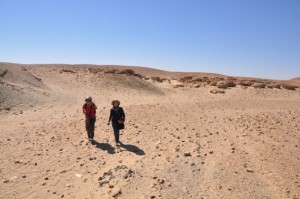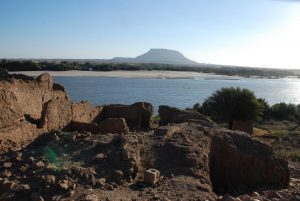The aim of the geoarchaeological fieldwork within the framework of AcrossBorders was to expand our knowledge about the existing rock types, their relationships, Quaternary sediments, geomorphological evolution and estimations about possible Nile erosion processes at the site of the Pharaonic settlement. The scarcity of vegetation, presence of riverfront exposures as well as excellent outcrops provided by excavated graves offer great geoarchaeological working conditions.
Sai Island is situated between the 2nd and 3rd Nile cataracts, which are a result of a large scale east-west trending tectonic uplift zone, which forces the Nile to incise into uplifted Neoproterozoic crystalline basement and its sedimentary cover (Thurmond et al. 2004). Consequently, Sai Island comprises medium-grade metamorphic Precambrian rocks (amphibolite, dolomite, quartzite, biotite gneiss, calcite marble) in the west and southeast, dipping around 30° towards the Northwest. These rocks are commonly cross-cut by large quartz-veins. In the central and northern part of the island these meta-volcano-sedimentary rocks are overlain by subhorizontal Nubian Sandstone, mainly consisting of medium- to coarse-grained fluvial quartz sandstone, conglomerate, rare siltstone and occasional silicified wood.

Yellowish Nubian Sandstone overlying dark amphibolite in the southeast part of Sai Island
Almost all of these rocks are covered by thin layers of comparably much younger Nile sediments (in some places with Palaeolithic artefacts) and only the Nubian Sandstone of Jebel Adu raises as an Inselberg from the flat terraces surfaces (van Peer et al. 2003, Anonymous 2005).

Example of small basement outcrop in the more fertile West of the island
The pre-Holocene Nile sediments mainly comprise gravely channel deposits and fine-grained floodplain sediments. The sub-rounded to rounded gravel of the pre-Holocene Nile terraces are strongly dominated by quartz clasts, followed by chert and beautiful agate and virtually free of carbonate clasts, while the fine-grained floodplain sediments commonly show soil formation processes and related calcrete (Lewis et al. 2011).

Photo showing typical composition and grain-size of gravelly terrace surfaces
The rock types occurring at the site of the Pharaonic settlement in general reflect the geological reality of the island and most of them are locally available. By far the most common rock types are quartz sandstone and amphibolite, while vein quartz, calcrete, biotite gneiss, calcite marble are comparable rare. Rock types which probably have been brought to the island include granite, diorite, gabbro and gypsum.
References:
Anonymous, Geological map of Sudan. 1 : 3,500,000, Geological Research Authority of the Sudan, Khartoum, 2005.
J. Lewis, J. Smith, & E. Garcea, Paleoenvironmental implications of the isotope geochemistry and granulometry of Quaternary alluvial sediments and paleosols from Sai Island, Sudan. GSA Annual Meeting, 9-12 October 2011, Minneapolis, abstract, 2011, 95-19.
A.K. Thurmond, R.J. Stern, M.G. Abdelsalam, K.C. Nielsen, M.M. Abdeen & E. Hinz, The Nubian Swell. Journal of African Earth Sciences, 39, 2004, 401-407.
P. Van Peer, R. Fullagar, S. Stokes, R.M. Bailey, J. Moeyersons, F. Steenhoudt, A. Geerts, T. Vanderbeken, M. de Dapper & F. Geus, The Early to Middle Stone Age Transition and the Emergence of Modern Human Behaviour at site 8-B-11, Sai Island, Sudan. Journal of Human Evolution, 45, 2003, 187-193.
 “Sâî is a difficult place to reach, unless the traveller has his own boat with him. On January 2nd, 1821, Cailliaud crossed the river on a raft made of reeds and pieces of palm trunk.” (Budge 1907, 463)
“Sâî is a difficult place to reach, unless the traveller has his own boat with him. On January 2nd, 1821, Cailliaud crossed the river on a raft made of reeds and pieces of palm trunk.” (Budge 1907, 463) “Hoskins in June, 1832, needed no raft, for the water in the Western channel only came up to the camel’s knees, and he passed over to the island from the mainland without difficulty.” (Budge 1907, 463)
“Hoskins in June, 1832, needed no raft, for the water in the Western channel only came up to the camel’s knees, and he passed over to the island from the mainland without difficulty.” (Budge 1907, 463) “Burckhardt, who must have been there in the winter, could obtain the use of neither ferry nor raft, and was therefore obliged to abandon his projected visit.” (Budge 1907, 463)
“Burckhardt, who must have been there in the winter, could obtain the use of neither ferry nor raft, and was therefore obliged to abandon his projected visit.” (Budge 1907, 463) “On the following morning we had our boats loaded early, and dropped down the Nile with the current; as there was no wind we made good progress. In about two hours we sighted a mass of ruined walls which were built on the extreme edge of the Island of Sâî, close to the river. We found a convenient place on the bank and landed, and then climbed up a steep, rough path to the remains of what is called the “Castle of Sâî.”” (Budge 1907, 461)
“On the following morning we had our boats loaded early, and dropped down the Nile with the current; as there was no wind we made good progress. In about two hours we sighted a mass of ruined walls which were built on the extreme edge of the Island of Sâî, close to the river. We found a convenient place on the bank and landed, and then climbed up a steep, rough path to the remains of what is called the “Castle of Sâî.”” (Budge 1907, 461) Reference
Reference


